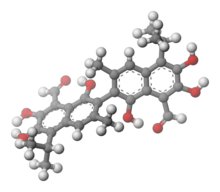Gossypol

| |

| |
| Names | |
|---|---|
| Preferred IUPAC name
1,1′,6,6′,7,7′-Hexahydroxy-3,3′-dimethyl-5,5′-di(propan-2-yl)[2,2′-binaphthalene]-8,8′-dicarbaldehyde | |
| Identifiers | |
3D model (
JSmol ) |
|
| ChEMBL | |
| ChemSpider | |
| DrugBank | |
ECHA InfoCard
|
100.164.654 |
IUPHAR/BPS |
|
| KEGG | |
PubChem CID
|
|
| UNII | |
CompTox Dashboard (EPA)
|
|
| |
| |
| Properties | |
| C30H30O8 | |
| Molar mass | 518.562 g·mol−1 |
| Appearance | Brown solid |
| Density | 1.4 g/mL |
| Melting point | 177 to 182 °C (351 to 360 °F; 450 to 455 K) (decomposes) |
| Boiling point | 707 °C (1,305 °F; 980 K) |
| Hazards | |
| GHS labelling: | |

| |
| Warning | |
| H351 | |
| P201, P202, P281, P308+P313, P405, P501 | |
Except where otherwise noted, data are given for materials in their standard state (at 25 °C [77 °F], 100 kPa).
| |
Gossypol (
Among other applications, it has been tested as a
Biosynthesis
Gossypol is a
Research
Contraception
A 1929 investigation in Jiangxi showed correlation between low fertility in males and use of crude cottonseed oil for cooking. The compound causing the contraceptive effect was determined to be gossypol.[6] In the 1970s, the
However, gossypol also had serious flaws. The studies also discovered an abnormally high rate (0.75%) of
In the mid-1990s, the Brazilian pharmaceutical company Hebron announced plans to market a low-dose gossypol pill called Nofertil, but the pill never came to market. Its release was indefinitely postponed due to unacceptably high rates of permanent infertility.[
Researchers have suggested gossypol might make a good noninvasive alternative to surgical vasectomy.[8]
In 1986, in conjunction with the Chinese Ministry of Public Health and the
Toxicity
Food and animal agricultural industries must manage cotton-derivative product levels to avoid toxicity. For example, only
References
- .
- S2CID 32120983.
- PMID 28575607.
- PMID 4318479.
- ^ ]
- ^ PMID 9639145.
- ^ a b c d e "Gossypol". Malecontraceptives.org. 2011-07-27. Archived from the original on 2013-05-18.
- PMID 12020773.
- PMID 9639146.
- ^ "Seeding Hope for Millions". Texas A&M Today. 2018-10-16. Retrieved 2019-10-07.
External links
 Media related to Gossypol at Wikimedia Commons
Media related to Gossypol at Wikimedia Commons

